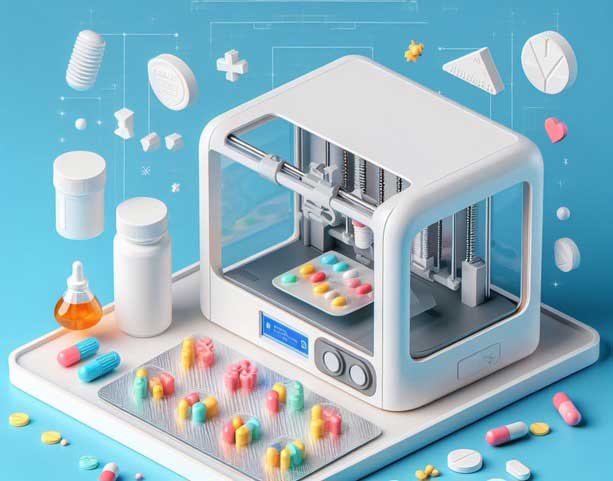Personalized medicine is becoming increasingly important in providing optimized and targeted treatment, especially for sensitive patient populations like children. Traditional drug manufacturing methods pose challenges in meeting children’s unique medication needs in areas like accurate dosing, palatability, and presentation. However, innovations in 3D printing technology show promise in overcoming many of these difficulties through the custom design of paediatric formulations. This is especially important in paediatrics, where there is large variability in the dosing requirements among children of different ages and weights. Recent advances in 3D printing offer innovative new possibilities for the development of personalized paediatric formulations (Patel, 2020). 3D printing, also known as additive manufacturing, works by depositing materials layer-by-layer based on a digital file to build a three-dimensional physical object (Gross et al., 2014). This technology has the ability to fabricate pre-determined doses and release profiles tailored to each young patient. Additionally, alternative dosage forms like orodispersible films may be manufactured via 3D printing, facilitating ease of dosing for children (Lopez et al., 2020). However, more research and regulatory guidance is still needed to translate these opportunities into commercial pediatric products. With further development, 3D printing is expected to transform age-appropriate formulations and enable more effective pharmacotherapy in pediatric populations.
Author: Prachi Khamkar; Director Atlaas Pharmaceutical and Director ReachSci India, UK
Children Have Special Medication Requirements
Children are not just little adults. Their developing bodies metabolize and react to medications differently than fully mature adults. Factors like age, weight, genetics, and physiology influence how a drug is processed. For example, babies cannot efficiently break down and clear medications, while teenagers may eliminate a drug more rapidly. Doses must be carefully calculated and adjusted based on the child’s developmental stage. Often, adult tablets or capsules need to be split or dissolved to achieve appropriate paediatric amounts, introducing possible errors and contamination.
Unfortunately, many drugs are not tested thoroughly and approved for use in children. Pediatric trials face ethical challenges given this vulnerable population. The lack of suitable formulations also hinders effective delivery of medicines in the necessary amounts and dosage forms. Liquid formulations, though easier to dose precisely, can have issues with taste, stability, and portability. If the medicine is unpalatable, children may refuse to take it, leading to poor adherence. There is a pressing need for more age-appropriate therapies that accommodate children’s preferences and ensure accurate dosing.
3D Printing Creates Opportunities for Personalized Paediatric Medicines
3D printing, also known as additive manufacturing, constructs objects layer-by-layer based on a digital blueprint. The technology is already widely used in making customized medical products like dental aligners, prosthetics, anatomical models for surgical planning, and medical devices. Pharmaceutical scientists recognize its potential for enabling personalized design features like shape, size, colour, release profiles, and multi-drug combinations in printed solid dosage forms.
Precision and Flexibility
The digitization of the printing pathway optimizes production flexibility while maintaining accuracy. Doctors can tailor medication strengths and combinations to each child’s unique requirements and preferences. For example, a nine-year old may need one drug dose, while her seven-year old brother needs a slightly adjusted amount of the same medicine based on his lower weight. 3D printing can fabricate these distinct doses with precise accuracy, preventing under- or overdosing issues. The same principle can apply in combining multiple drug substances in polypills while maintaining controlled release rates. This consolidation into a simpler dosage regimen favours adherence to complex therapies.
Drug Release Control
By modulating properties like the internal structure, geometrical shape, and polymer matrix composition of a 3D printed dosage form, researchers can program specific patterns of drug release over time. For example, by fabricating a multi-layer tablet with drug-containing hot melt extruded filaments sealed by blank filaments, sustained zero-order release kinetics were achieved for up to 16 hours. Such extended release forms reduce the number of times medicine must be administered, improving adherence.
Acceptability and Adherence
Strict dosage requirements, fear of medications, and swallowing difficulties are some barriers to paediatric adherence. But 3D printing lets scientists appeal to children’s preferences in taste masking, shape, colour, and size during dosage form design. For example, low-dose tablets with appealing colours and fruit flavour demonstrated good acceptability among children. Whimsical shapes like hearts, stars, or popular cartoon characters also distract from the medicine’s purpose. By disguising the drug’s presence, 3D printing boosts medication acceptance and adherence.
Opportunities in Low Resource Settings
Economical desktop 3D printers enable small-batch production of personalized medicines tailored to each patient’s needs, directly onsite in community or hospital pharmacies. Such distributed manufacturing avoids large upfront capital investments in dedicated production lines and extensive global supply chains. Short turnaround times from design to product means medications can be promptly adjusted based on changing requirements or unexpected circumstances like drug shortages. As an agile make-on-demand technology, 3D printing empowers healthcare providers with greater self-sufficiency in serving their local patient populations.
Current Applications in Paediatric 3D Printed Medicines
So far, research has focused largely on filament extrusion techniques like fused deposition modeling and semisolid extrusion printing. Model drugs like caffeine, paracetamol, ibuprofen, and hydrocortisone have been incorporated into paediatric formulations spanning mini tablets, orodispersible films, oral powders, soft chews, and suspensions. Early studies demonstrate flexibility in designing precise doses, combinations, sizes, shapes, and release patterns tailored to young patients. For example, one group achieved weight-based, personalized dosing of suspending vehicles for premature new-borns in the neonatal intensive care unit through on-demand 3D printing from their electronic medical records. As regulations and the technology mature, more complex customized paediatric regimens leveraging multiple APIs could reach clinical testing and practice.
Challenges in Translation to Practice
While optimistic about 3D printing’s prospects, researchers caution that several barriers still obstruct widespread adoption into paediatric practice:
- Regulatory Ambiguity – Laws surrounding personalized 3D printed products remain vague. Governance frameworks defining their regulatory classification, quality standards, pharmacovigilance procedures, and intellectual property protections require further development by policymakers in collaboration with experts.
- Technological Limitations – Available 3D printers lack features specially adapted for pharmaceutical fabrication, impeding consistent quality and sterility. Most systems cannot handle all possible dosage forms. Material selection remains restricted.
- Personnel Barriers – Healthcare staff require specialized expertise in both 3D technology operations and digital pharmaceutical design. Clearer professional guidelines are needed.
- Ethical Uncertainties – Balancing public good against individual preference needs thoughtful deliberation.
Future Outlook
Nonetheless, the disruptive potential of distributed, agile 3D fabrication of treatments uniquely tailored to paediatric requirements cannot be ignored. As tabletop systems advance in precision, speed, connectivity, and material versatility, wider adoption beyond exploratory research should accelerate (Chen et al., 2016). Innovations in bioprinting may even one day enable on-demand solid dosage forms with active encapsulated ingredients like living cells. With thoughtful governance and social engagement guiding the safe and ethical application of this technology, it could drastically reshape paediatric practice – anywhere in the world – through democratized local manufacturing driven by patient needs instead of commercial dictates. The ultimate promise is healthier children and families through precision paediatric medicines for all.
References:
• Gross, B.C., Erkal, J.L., Lockwood, S.Y., Chen, C. and Spence, D.M., 2014. Evaluation of 3D printing and its potential impact on biotechnology and the chemical sciences. Analytical chemistry, 86(7), pp.3240-3253.
• Lopez, F.L., Bowles, S., Gul, M.O. and Kadhirvel, P., 2020. Formulation of 3D printed paediatric medicines-Opportunities and challenges. Pharmaceutics, 12(10), p.984.
• Patel, A., 2020. Applications of 3D Printing Technology to Address Challenges in Pediatric Pharmaceutical Product Development. The AAPS journal, 22(1), pp.1-12.
• Chen, J.F., Sermanet, P. and Lediju Bell, M.A., 2016. 3D printing personalized paediatric medicines. The Clinical Teacher, 13(5), pp.345-349.
 Prachi Khamkar serves as Director at Atlaas Pharmaceutical, where she pursues her passions for pharmaceutical 3D printing and personalized medicine. Holding a pharmaceutical sciences degree with research specialization in topical drug delivery, she also holds an India Director position at ReachSci in University of Cambridge. Additionally, Khamkar studied business management in London. With articles and book chapters published internationally, Khamkar contributes valuable industry knowledge and leadership – furthering pharmaceutical innovation through cutting-edge technologies and patient-centered approaches.
Prachi Khamkar serves as Director at Atlaas Pharmaceutical, where she pursues her passions for pharmaceutical 3D printing and personalized medicine. Holding a pharmaceutical sciences degree with research specialization in topical drug delivery, she also holds an India Director position at ReachSci in University of Cambridge. Additionally, Khamkar studied business management in London. With articles and book chapters published internationally, Khamkar contributes valuable industry knowledge and leadership – furthering pharmaceutical innovation through cutting-edge technologies and patient-centered approaches.Subscribe to our Newsletter
3DPresso is a weekly newsletter that links to the most exciting global stories from the 3D printing and additive manufacturing industry.






















